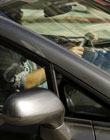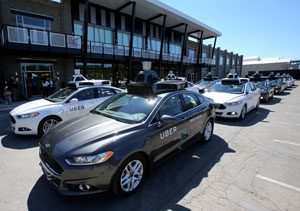Top>Research>Legal Issues Surrounding Autonomous Driving
 Index
Index

Photograph provided by Kyodo News
Legal Issues Surrounding Autonomous Driving
Keiko Kobue
Attorney
Visiting Professor, Chuo Law School
1. Council on Investments for the Future
At the Council on Investments for the Future held on March 30, 2018, the Japanese government summarized an overview for system development aimed at achieving autonomous driving. This was despite a fatal accident involving a self-driven Uber car having just occurred on March 19 in America. I had been having mixed feelings towards autonomous driving following the accident, but encountering the optimistic reporting by the Japanese media caused me to reexamine the issue.
2. Liability for accidents involving self-driven vehicles

Photograph provided by Kyodo News
The Uber accident has sparked a wide range of discussion. However, who is actually liable (in this discussion, we are referring to civil liability) if a self-driven vehicle causes an accident?
Autonomous driving can be divided into many different levels. However, the most common image of autonomous driving is that the driver does not perform any operations and therefore cannot be negligent; therefore, it is naturally assumed that the manufacturer of the self-driven vehicle is liable.
However, when excluding accidents resulting in property damage and focusing strictly on accidents resulting in personal injury, liability as defined in current laws does not arise from mistaken driving operations by the driver.
In Japan, the Automobile Liability Security Act was put into effect in 1955. According to Article 3 of the Act, the subject of liability is the vehicle operator defined as “a person that operates an automobile for itself.” However, the proviso to Article 3 also states that the vehicle operator is not liable if he/she proves that 1) neither he/she nor the driver (a person who drives for a vehicle operator) failed to exercise due diligence in operating the vehicle, 2) there was an intention or negligence on the part of the victim or a third party other than the driver, and 3) there was no structural defect or functional disorder in the automobile. The Automobile Liability Security Act enhances relief for the victim by effectively placing strict liability on the vehicle operator (for that very reason, the Automobile Liability Security Act regulates automobile liability insurance which covers said liability).
The vehicle operator is not held liable because he/she is driving the vehicle or made a mistake while driving; instead, liability exists because he/she controls the transportation service and is obtaining profit from the service. Fundamentally, control of transportation service and profit from service is attributable to the owner under the Automobile Liability Security Act. For example, consider the case of a taxi. Although the steering wheel is being gripped by a driver who is an employee of the taxi company, it is the taxi company that actually controls operation of the taxi and obtains profit from taxi service. Therefore, the taxi company is liable for accidents involving the taxi.
Based on the liability structure of the Automobile Liability Security Act, it is reasonable to state that, generally speaking, it is the owner of the vehicle who controls the transportation service and obtains profit from the service, regardless of whether driving is performed by a human being or by a machine.
Accordingly, for the time being, victims of accidents caused by self-driven vehicles will receive relief based on the victim relief system of the current Automobile Liability Security Act. In its recent overview, the Council on Investments for the Future reached the same conclusion based on reports issued by the MLIT’s Research Council on Liability for Damages in Autonomous Driving.
3. Fair distribution of damages
Nevertheless, the fact that the vehicle operator is held liable does not excuse the manufacturer from liability. Similar to normal accidents involving manufactured products, manufacturers are subject to product liability if an accident were to occur due to a defect in the automobile.
However, the Product Liability Act requires that the victim/user proves that the manufactured product is defective. This is extremely difficult to prove. In the case of personal injury caused by a self-driven vehicle, there is application of automobile liability insurance (compulsory insurance). Optional insurance (additional insurance) is also widely used. Accordingly, the primarily liable insurance company will attempt to use product liability when seeking reimbursement from the manufacturer. Still, even for an insurance company, proving that a defect existed in a self-driven automobile is no easy task.
Answers have yet to be found for how to address these difficulties. However, some useful hints for finding answers are coming into focus.
Accidents involving self-driven vehicles involve a large number of parties such as the victim, vehicle operator, driver, user, employees, and manufacturer. Another factor is insurance including mandatory automobile liability insurance, optional automobile liability insurance, and product liability insurance. The question of how to fairly distribute damage will be a major issue during the transition period spanning from a mixture of human-driven and self-driven vehicles until the realization of a society using only self-driven vehicles.
4. Toward the future
When I handle civil cases as a representative of the parties thereto, I focus on resolving past cases and directing the vector of parties towards the future. In particular, there is a great need for legal professionals to take the initiative in expanding discussion regarding autonomous driving towards the future.
When I think about autonomous driving, I recall the day long ago that I enrolled in the Chuo University Faculty of Law—despite the heavy rain which poured down that day, I felt cheerful for some reason.
- Keiko Kobue/Attorney
Visiting Professor, Chuo Law School - Keiko Kobue graduated from the Department of Law in the Faculty of Law, Chuo University.
She was born in Tokushima Prefecture and graduated from Tosa Senior High School. She served her apprenticeship in Takamatsu as a member of the 45th class of the Judicial Research and Training Institute.
Currently, she works as an attorney and as a Visiting Professor in the Chuo Law School.
- Research Activities as a Member of Research Fellowship for Young Scientists (DC1), Japan Society for the Promotion of Science (JSPS) Shuma Tsurumi
- Important Factors for Innovation in Payment Services Nobuhiko Sugiura
- Beyond the Concepts of Fellow Citizens and Foreigners— To Achieve SDGs Goal 10 “Reduce Inequality Within and Among Countries” Rika Lee
- Diary of Struggles in Cambodia Fumie Fukuoka
- How Can We Measure Learning Ability?
—Analysis of a Competency Self-Assessment Questionnaire— Yu Saito / Yoko Neha - The Making of the Movie Kirakira Megane








